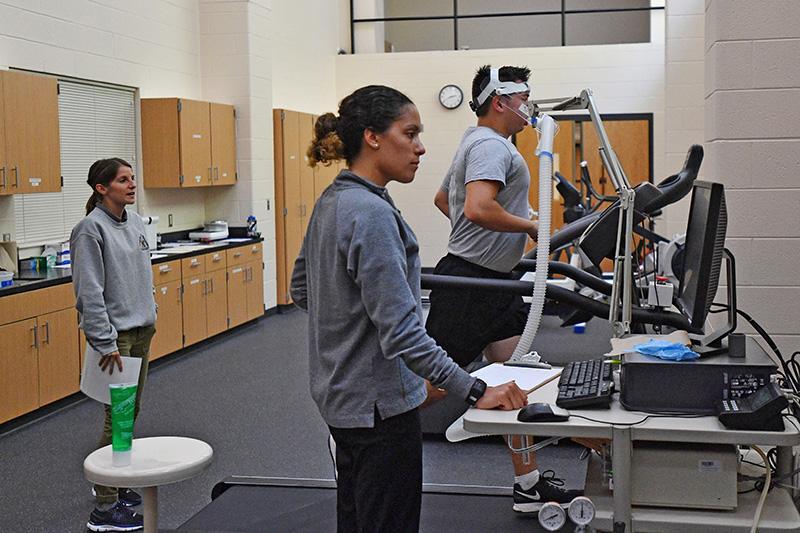What is the Caloric Cost of the Rat Line?

Bethany King '18 and Capt. Katherine Gorman perform a VO2max test on one of the study's participants in Cormack Hall.—VMI Photo by Ashlie Walter.
LEXINGTON, Va., August 11, 2017—Cadets never forget their time in the Rat Line, but many might not have stopped to think about the exact physical effort that goes into completing the events from Matriculation Day to Breakout.
For her senior capstone project, Bethany King ’18 is studying the caloric cost of the Rat Line under the guidance of Capt. Katherine Gorman of the physical education department. She chose the study as her capstone because, as someone who went through the same training while participating in NCAA athletics, she wanted to quantify the physical demands of the Rat Line.
The pair recruited 15 cadets during the Summer Transition Program. Only 14 are actively participating in the semester-long study, while the 15th cadet is an alternate.
During the Summer Transition Program, the cadets went through a fitness test in Cormack Hall’s exercise science lab to establish their baseline maximal oxygen consumption or VO2max—how much oxygen their body can consume during vigorous exercise intensity—and their body fat composition.
“We put them on a treadmill and increase intensity; we look at what is happening to their heart rate and more importantly, to their oxygen consumption, which is directly tied to energy expenditure,” said Gorman. The aim of the study is to determine “ultimately, what is the caloric cost of the Rat Line?”
Those levels will be tested again six weeks after starting in the Rat Line, with the study wrapping up the week before finals. King added that was a good endpoint for the study because, after finals, the cadets go on Christmas Furlough and then the training changes for them before Breakout.
While participating in Rat Line activities, the cadets will be wearing Polar heart rate monitors to measure their heart rate, steps, and sleep activity.
“That’s why this study is so novel, this technology didn’t exist 10 years ago. It links the lab and field together,” Gorman said.
Past studies of the Rat Line at VMI had cadets perform typical rat activities in a lab setting. The majority of those studies were led by biology professor Col. Tom Baur.
King said the data collected from the study could be used during basic or advanced training in the military which is similar to the Rat Line.
Gorman and King hope to publish the data in an exercise science journal.
“At this point, we are just observing and collecting data to determine the demands of the Rat Line. The hope is that we can better understand VMI and the Rat Line experience. Possibly, this information could be helpful to those designing physical programming in the future,” Gorman said.
As far as the caloric intake part of the equation, King will take pictures of the cadets’ food before and after they eat in Crozet. They will then estimate how many calories the cadets consumed based on the images.
Gorman said when doing research that involves subjects keeping a diary of what they have eaten, there is a greater risk for error.
“These guys are going to be under a lot of stress,” she said “We don’t want to put that responsibility on them.”
All the cadets participating are male and not participating in any NCAA sports. Gorman added they needed a homogeneous group of people at VMI to calculate better data. In the future, she hopes to explore other groups who go through the Rat Line such as a female-only group or NCAA athletes.
King is pursuing an exercise science minor, and she hopes to attend dental school after graduation. King is currently on the women’s cross country team at VMI.
-Ashlie Walter
–VMI–
.svg)
.png)